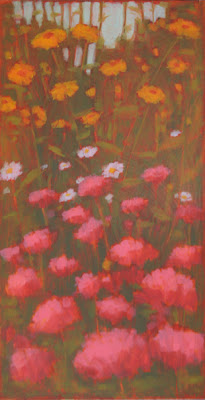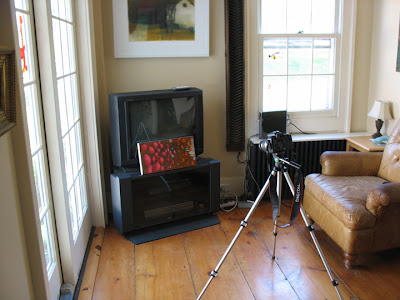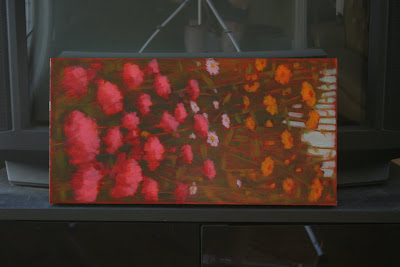 Crowded Garden 1. 2007, Oil on Panel, 9"x18"
Crowded Garden 1. 2007, Oil on Panel, 9"x18"Well, back to more current issues today. I have been meaning to answer Giselle's question from last week concerning photographing my paintings.
Because of the layers, the saturated colors and the translucency of my paintings, they can be very difficult to photograph. Professional photography really isn't an option for me for three good reasons:
1. cost
2. convenience
3. there are no photographers anywhere near us
Number 3 is obviously the clincher.
So I am lucky in that Doug has a background in photography and for the first few years we tried all kinds of set-ups, including taking the shots under lights as well as outside in natural light. None of those worked very well, and the images required a lot of work in photoshop in order to get them to actually look like the painting. Finally, we found one spot in our house that has the perfect balance of reflection and natural light, provided it's a relatively bright day, of course. So I take all of the photographs here, in our tv room:

Quite professional, eh? At first we used Doug's old digital camera, a Nikon Coolpix 990, which I believe was one of the first models ever made. Heh. It had gotten a lot of use and finally you had to squeeze down on the battery area while pressing the shutter in order for the camera to record the image. Then a few years ago, for Christmas I gave Doug a super duper way cool Canon EOS 20D digital camera, and we began to use that for the photos. Doug showed me how to use it and I know just the basics, enough for me to be able to take the shots that I need to document my work. I do have my own digital camera, a Canon PowerShot A610, which I use for taking reference photos and for personal use. I have tried to use it for the paintings but the photos didn't have the quality or clarity that the Canon does. So one of these days I may have to buy my own 20D, and maybe Doug can have his back again!
Once the shots are taken, they are downloaded to my computer and into photoshop. Doug had previously handled all of the photoshop work, but he is always busy with his work and I didn't like having to depend on him for all of that. So I have gradually learned how to download the images, save and label the files and how to use photoshop. Sort of. I can handle the basics, and luckily because the spot where I take the photos is so nicely balanced, the photos don't need too much work. This is what I start with:

Usually all I have to do is crop and skew, lighten the image, and maybe slightly adjust the hue/saturation, brightness/contrast levels. Then I save it as a jpeg twice, one at 72dpi and one at 300dpi. When I name the file, it has the title, the dpi, and an excellent suggestion came from one of my gallery directors, which was that I include the size of the painting on the label as well. I can't tell you how handy it is to have that info so easily available. Then I save each file in a folder according to the year the painting was created.
At first I sent the digital files to a company in California that made slides from them. But I have gradually stopped doing that, as I really have no need for slides anymore. If I do send out images anymore, I email them or load everything onto a CD. And competitions are accepting digital files more and more as well.
Anyway, I have this system down pat now and while it can be a pain in the neck, as all documentation work can be, I can literally have a finished image in less than ten minutes of actually painting the last stroke. And although the painting looks better in real life (and thank god it does, how awful for it to be the other way around!) I think the images are very good representations of my work.
Besides I am happy that my work keeps a few secrets, only to be revealed in person.

6 comments:
Documentation bug must be going around. I just was mentioning it myself. I still go outside with the SLR for slides until all my film is gone. I also take with the Canon Rebel XT and save just like you do except for the size thing. That might be a good idea, too.
I know one thing, I won't miss labeling slides one bit.
Love the flowers! You are so talented!
Shirley
Seriously! This craving order and documentation must be a full-moon function.
This morning I was telling self that I needed to devote some days to new digital images and making that comprehensive database I have been imagining for too long.
This is such a persistant problem for many of us, thanks for posting. I use a flat bed digital scanner for paintings 9x12 and smaller. The scans are perfect (also a Canon product)! I know another artist blogger (Mike Baily) that blogged about a light box that he built that works well.
Cheryl, Yes, I am not missing slides either, labeling them, storing them, even looking at them is a pain in the neck!
Thanks Shirley!
Deb, Comprehensive database? Yikes. Except for the digital images, I have a very archaic system for record keeping, and comprehensive database sounds really scary:)
Ed, I used to scan my smaller pieces and they were ok. But I don't have a really good scanner and once I figured out how to do set up the photo shots, I stopped using the scanner entirely. The light box set-up sounds interesting.
Tracy,
Thank you for such a thorough post! Your process is pretty similar to mine, actually. Photoshop, etc. I was curious if you were also doing regular slides as well, and you answered that.
I was out of town, and it's nice to be back catching up on email & my favorite websites!
Post a Comment